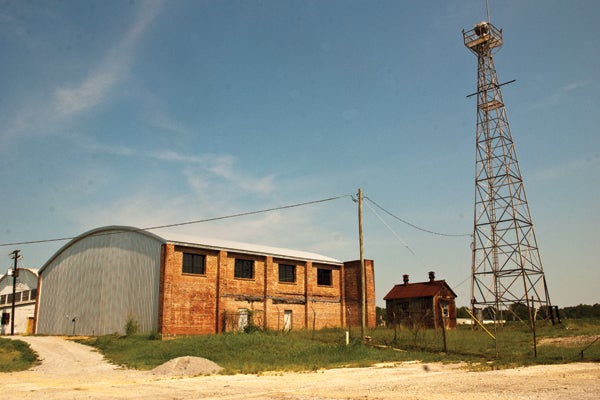
Chilton County is known for historic fixtures. From Maplesville’s train depot to the columns of the original Chilton County High School, there are several places in the area that hold historical value. Of all the places, there are only three that have been placed on the National Registry of Historic Places: Gragg Wade Field, the community of Verbena and the Walker-Klinner Farm in Maplesville.
GRAGG WADE FIELD
Many people don’t realize just how significant a place in history the Chilton County Airport holds. It was constructed in 1937 as part of the New Deal’s Works Progress Administration.
That opening weekend was quite a spectacle. Held over the July 4, 1937 weekend, the Chilton County Airport began its service with a bang. According to an article from the July 1937 edition of the Clanton Union-Banner, “Hundreds of local residents attended the landmark event,” which included parachute jumps, a model plane contest, a demonstration of formation flying by the Alabama National Guard, aerobatics, a street dance on Saturday night and plane rides on both days.
The festivities lasted all weekend (with a break on Sunday for church, of course), and people from all around the area came to see the new addition, which boasted 50 acres and three all grass runways.
During the Second World War, the airport was utilized by the government to train people with an interest in aviation how to fly, with the understanding that they would be called upon if needed during the war.
Following the war, the airport saw action as an emergency landing field on Commercial Airmail Route 40 (Site 27) between Memphis and Tampa, Fla. The airport’s hangars were also used for various community functions and social events.
In 1948, the airport acquired a piece of U.S. History at virtually no cost. The city of Clanton purchased a hangar once used to house the planes of the famous Tuskegee Airmen for just $10,000.
The hangar still stands and is the famous baby blue building most visible from the road. After the hangar was brought to the field, the east-west runway was paved, and the airport was designated for general aviation, which it is still classified as today.
The four buildings, better known as the Gragg Field Historic District, were listed on the National Registry of Historic Places on June 2, 2004, but over the years, the airport fell into a state of disrepair. The original WPA hangar became unusable, as did the original light tower and power shed. Things go so bad that, in 2007, the three buildings were listed as the “most endangered historic places in Alabama.”
In 2009, however, a group of pilots came together to fund renovations, and in 2010 the WPA hangar was reopened to house aircraft for the first time in more than 60 years.
COMMUNITY OF VERBENA
At one time, the tiny community of Verbena, about 10 miles from Clanton, was quite the booming town.
In the 1870s, socialites from Montgomery viewed Verbena as a vacation haven for more than one reason. Yes, the natural beauty of the place is enough to make anyone want to spend a summer, but those from the Capital City were trying to avoid a heavy threat: Yellow Fever.
Montgomery, being a port town of sorts, was a hotbed for the disease, and so those with money decided to make the trip up to the town and stay through the summer months.
Those who came up didn’t just intend to stay in small cottages, either. Elaborate homes were built, and with those homes came luxuriant parties.
Daniel Pratt had a lumber mill to make slats for venetian blinds, and there was a hotel, which housed doctors from the Confederate Veterans’ Home.
For awhile, even famous Southern poet Sidney Lanier called the town home. Lanier, who suffered from tuberculosis, made his home in a grove of pine trees in order to try and combat the disease. He was known to play his flute in parlors as a form of entertainment.
Aside from a spike during the building of Mitchell Dam, the town’s economy and significance as a trade center began to taper off.
The invention of the automobile and Highway 31 cut down travel times, and so the town hotel wasn’t needed as much. Yellow Fever eventually went away, and so the socialites from Montgomery stopped coming. The buildings, however, remained, and people continued to maintain and live in them.
In 1976, through the guidance of a man named Henry Wingate, the town of Verbena was added to the National Registry of Historic Places, forever sealing its place in history.
WALKER KLINNER FARM
The Walker Klinner Farm, located in Maplesville, is a homestead that belonged to one of Chilton County’s most famous families.
William Walker, the man who built the farm, came to what is now Autauga County from Mecklenburg, N.C. He became well renowned after being contacted to build the Autauga County Courthouse in 1857, and operated a cotton gin and water gristmill later on.
In the 1880s, Walker purchased the land the farm currently sits on and began building.
The structure that gathers the most attention is without a doubt the main house. The two-story Eastlake style home is located three and a half miles east of Maplesville, and is a jewel.
The exterior of the house is a combination of pastel yellow walls made up of weatherboard, with a mint green tin roof. The house is trimmed in dark red.
It boasts of four chimneys, a massive porch, and another house in the back, among other buildings on the property.
It was placed on the National Registry of Historic Places on Oct. 1, 1987, and is currently owned by the Klinner family.
